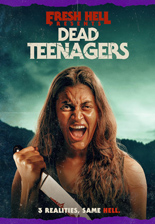
Not sure about buying that creepy fixer-upper? It’s tough. Yes, someone will almost certainly decorate the banisters with your vital organs. But just look at the size of that courtyard!
Like seriously, the setting of Damian Mc Carthy’s Oddity is one of the most ideal horror locations since Fede Alvarez’s Don’t Breathe. On top of it all, Mc Carthy makes the most out of this inevitably haunted house with a modern ghost story that’s as deliciously cheesy as it is entertaining.
Hospital director Ted (Gwilym Lee, Bohemian Rhapsody) and his wife, Dani (Carolyn Bracken, You Are Not My Mother), are in midst of renovating their “dream” home. Dani is bludgeoned to death as Ted works a night shift at the friendly neighborhood psych ward. A year later, Ted visits Dani’s twin sister, Darcy (also Bracken), a blind psychic and owner of an oddity shop. After Darcy touches the glass eye of the late suspected killer, Ted’s old patient (Tadhg Murphy, The Northman), Darcy realizes the truth is messier than the crime scene. With a terrifying wooden doll in tow, the psychic resolves to avenge her sister’s murder and arrives uninvited to Ted’s home.

Some may not think of this as a weakness, but Oddity’s biggest hurdle comes from its stiff and long-winded dialogue. It doesn’t help that most of the performances (save Lee’s) can’t muster much to soften that rigidity. Certain exchanges between characters feel like they never quite got out of rehearsal, coming just short of the Stuart Gordon tone Mc Carthy tries to strike.
That said, stilted and awkward deliveries don’t hold the film back too much. In some ways, it lends itself to the idea no one in Oddity should be taken at face value. Even if you predict where the film is going — and you probably will — Mc Carthy keeps us hungry for the killer’s comeuppance with captivating charm. It also manages to pay off its ending, satisfying a seemingly random aside that still has something powerful to say about belief without overtly jamming it down our throats.
Even Oddity’s jump scares avoid falling into an uninspired formula. It feels familiar, sure, but these sequences aren’t concerned reinventing the wheel or making up for a lackluster plot. It almost feels like Mc Carthy could’ve abandoned some of the surprises outright and the film still would’ve landed in a satisfying place. Still, the director gets creative, and the heart poured into Oddity beautifully pulses and twitches on screen.
Oddity refuses to take itself too seriously, not so much leaning on ’80s convention as it is celebrating it. And by doing so, it reminds us that not every horror flick needs to be a jarring mediation of grief or, in the Terrifier franchise’s case, grotesque slapstick. Sometimes, watching someone chased out of a creepy house by a pissed ghost is enough. —Daniel Bokemper









